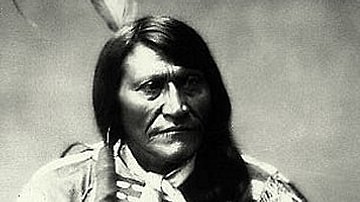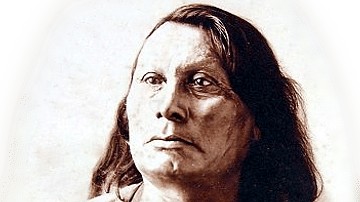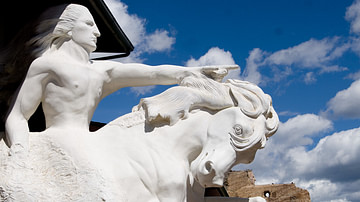Charles A. Eastman's biography of Crazy Horse (l. c. 1840-1877) is among the most significant sources on the great Sioux war chief, as Eastman drew on accounts of those who had known and fought alongside him in writing it. The work differs, slightly, from the account given in Black Elk Speaks.

Black Elk (l. 1863-1950) was an Oglala Sioux medicine man and Crazy Horse's second cousin, and so it is assumed he would be an authority on the subject. Black Elk Speaks (1932), however, has been criticized by scholars because the account was given to the American poet and writer John G. Neihardt (l. 1881-1973) through an interpreter, and, it has been claimed, Neihardt may have misunderstood aspects of the narrative as he did not know the language or culture and, further, may have purposefully shaped the story for a white audience.
Eastman's account, from his Indian Heroes and Great Chieftains (1916), is thought to be more accurate as Charles A. Eastman (also known as Ohiyesa, l. 1858-1939) was a Sioux author and physician, educated in Euro-American schools but well versed in Sioux culture, history, and language. Critics of both accounts have noted that each has strengths and weaknesses, which balance them out when read together.
The most significant difference in the two accounts concerns Crazy Horse's vision. Black Elk devotes a detailed paragraph to the vision he claims helped shape Crazy Horse's life while Eastman maintains that no one knows what his vision was. Other differences are minor, including Eastman's account of Crazy Horse rescuing the warrior Hump, which, in Black Elk's narrative, is given as Crazy Horse rescuing his younger brother. Both narratives are important historical documents in relating the biography of the great Sioux warrior whose life became legendary even while he lived.
Text
The following is taken from Eastman's Indian Heroes and Great Chieftains, the 1939 edition, republished in 2016. The text has been edited for space considerations, but the unabridged version will be found below in the External Links section.
Crazy Horse was born on the Republican River about 1845. He was killed at Fort Robinson, Nebraska, in 1877, so that he lived barely thirty-three years.
He was an uncommonly handsome man. While not the equal of Gall in magnificence and imposing stature, he was physically perfect, an Apollo in symmetry. Furthermore, he was a true type of Indian refinement and grace. He was modest and courteous as Chief Joseph; the difference is that he was a born warrior, while Joseph was not. However, he was a gentle warrior, a true brave, who stood for the highest ideal of the Sioux. Notwithstanding all that biased historians have said of him, it is only fair to judge a man by the estimate of his own people rather than that of his enemies…
At the age of sixteen he joined a war party against the Gros Ventres. He was well in the front of the charge, and at once established his bravery by following closely one of the foremost Sioux warriors, by the name of Hump, drawing the enemy's fire and circling around their advance guard. Suddenly Hump's horse was shot from under him, and there was a rush of warriors to kill or capture him while down. But amidst a shower of arrows the youth leaped from his pony, helped his friend into his own saddle, sprang up behind him, and carried him off in safety, although they were hotly pursued by the enemy. Thus, he associated himself in his maiden battle with the wizard of Indian warfare, and Hump, who was then at the height of his own career, pronounced Crazy Horse the coming warrior of the Teton Sioux.
At this period of his life, as was customary with the best young men, he spent much time in prayer and solitude. Just what happened in these days of his fasting in the wilderness and upon the crown of bald buttes, no one will ever know…
He loved Hump, that peerless warrior, and the two became close friends, in spite of the difference in age. Men called them "the grizzly and his cub." Again and again the pair saved the day for the Sioux in a skirmish with some neighboring tribe. But one day they undertook a losing battle against the Snakes. The Sioux were in full retreat and were fast being overwhelmed by superior numbers. The old warrior fell in a last desperate charge; but Crazy Horse and his younger brother, though dismounted, killed two of the enemy and thus made good their retreat.
It was observed of him that when he pursued the enemy into their stronghold, as he was wont to do, he often refrained from killing, and simply struck them with a switch, showing that he did not fear their weapons nor care to waste his upon them. In attempting this very feat, he lost this only brother of his, who emulated him closely. A party of young warriors, led by Crazy Horse, had dashed upon a frontier post, killed one of the sentinels, stampeded the horses, and pursued the herder to the very gate of the stockade, thus drawing upon themselves the fire of the garrison. The leader escaped without a scratch, but his young brother was brought down from his horse and killed…
He attained his majority at the crisis of the difficulties between the United States and the Sioux…[He] was twenty-one years old when all the Teton Sioux chiefs (the western or plains dwellers) met in council to determine upon their future policy toward the invader. Their former agreements had been by individual bands, each for itself, and everyone was friendly. They reasoned that the country was wide, and that the white traders should be made welcome. Up to this time they had anticipated no conflict. They had permitted the Oregon Trail, but now to their astonishment forts were built and garrisoned in their territory.
Most of the chiefs advocated a strong resistance. There were a few influential men who desired still to live in peace, and who were willing to make another treaty. Among these were White Bull, Two Kettle, Four Bears, and Swift Bear. Even Spotted Tail, afterward the great peace chief, was at this time with the majority, who decided in the year 1866 to defend their rights and territory by force. Attacks were to be made upon the forts within their country and on every trespasser on the same.
Crazy Horse took no part in the discussion, but he and all the young warriors were in accord with the decision of the council. Although so young, he was already a leader among them…The attack on Fort Phil Kearny was the first fruits of the new policy, and here Crazy Horse was chosen to lead the attack on the woodchoppers, designed to draw the soldiers out of the fort, while an army of six hundred lay in wait for them. The success of this stratagem was further enhanced by his masterful handling of his men. From this time on a general war was inaugurated; Sitting Bull looked to him as a principal war leader, and even the Cheyenne chiefs, allies of the Sioux, practically acknowledged his leadership. Yet during the following ten years of defensive war, he was never known to make a speech, though his teepee was the rendezvous of the young men. He was depended upon to put into action the decisions of the council and was frequently consulted by the older chiefs…
Early in the year 1876, his runners brought word from Sitting Bull that all the roving bands would converge upon the upper Tongue River in Montana for summer feasts and conferences. There was conflicting news from the reservation. It was rumored that the army would fight the Sioux to a finish; again, it was said that another commission would be sent out to treat with them.
The Indians came together early in June and formed a series of encampments stretching out from three to four miles, each band keeping separate camp. On June 17, scouts came in and reported the advance of a large body of troops under General Crook. The council sent Crazy Horse with seven hundred men to meet and attack him. These were nearly all young men, many of them under twenty, the flower of the hostile Sioux. They set out at night so as to steal a march upon the enemy, but within three or four miles of his camp they came unexpectedly upon some of his Crow scouts. There was a hurried exchange of shots; the Crows fled back to Crook's camp, pursued by the Sioux. The soldiers had their warning, and it was impossible to enter the well-protected camp. Again and again Crazy Horse charged with his bravest men, in the attempt to bring the troops into the open, but he succeeded only in drawing their fire.
Toward afternoon he withdrew and returned to camp disappointed. His scouts remained to watch Crook's movements, and later brought word that he had retreated to Goose Creek and seemed to have no further disposition to disturb the Sioux. It is well known to us that it is Crook rather than Reno who is to be blamed for cowardice in connection with Custer's fate. The latter had no chance to do anything, he was lucky to save himself; but if Crook had kept on his way, as ordered, to meet Terry, with his one thousand regulars and two hundred Crow and Shoshone scouts, he would inevitably have intercepted Custer in his advance and saved the day for him, and war with the Sioux would have ended right there. Instead of this, he fell back upon Fort Meade, eating his horses on the way, in a country swarming with game, for fear of Crazy Horse and his braves!
The Indians now crossed the divide between the Tongue and the Little Big Horn, where they felt safe from immediate pursuit. Here, with all their precautions, they were caught unawares by General Custer, in the midst of their midday games and festivities, while many were out upon the daily hunt.
On this twenty-fifth of June 1876, the great camp was scattered for three miles or more along the level river bottom, back of the thin line of cottonwoods—five circular rows of teepees, ranging from half a mile to a mile and a half in circumference. Here and there stood out a large, white, solitary teepee; these were the lodges or "clubs" of the young men. Crazy Horse was a member of the "Strong Hearts" and the "Tokala" or Fox lodge. He was watching a game of ring-toss when the warning came from the southern end of the camp of the approach of troops.
The Sioux and the Cheyenne were "minute men", and although taken by surprise, they instantly responded. Meanwhile, the women and children were thrown into confusion. Dogs were howling, ponies running hither and thither, pursued by their owners, while many of the old men were singing their lodge songs to encourage the warriors, or praising the "strong heart" of Crazy Horse.
That leader had quickly saddled his favorite war pony and was starting with his young men for the south end of the camp, when a fresh alarm came from the opposite direction, and looking up, he saw Custer's force upon the top of the bluff directly across the river. As quick as a flash, he took in the situation—the enemy had planned to attack the camp at both ends at once; and knowing that Custer could not ford the river at that point, he instantly led his men northward to the ford to cut him off. The Cheyenne followed closely. Custer must have seen that wonderful dash up the sage-bush plain, and one wonders whether he realized its meaning. In a very few minutes, this wild general of the plains had outwitted one of the most brilliant leaders of the Civil War and ended at once his military career and his life.
In this dashing charge, Crazy Horse snatched his most famous victory out of what seemed frightful peril, for the Sioux could not know how many were behind Custer. He was caught in his own trap. To the soldiers it must have seemed as if the Indians rose up from the earth to overwhelm them. They closed in from three sides and fought until not a white man was left alive. Then they went down to Reno's stand and found him so well intrenched in a deep gully that it was impossible to dislodge him. [Sioux war chief] Gall and his men held him there until the approach of General Terry compelled the Sioux to break camp and scatter in different directions.
While Sitting Bull was pursued into Canada, Crazy Horse and the Cheyenne wandered about, comparatively undisturbed, during the rest of that year, until in the winter the army surprised the Cheyenne, but did not do them much harm, possibly because they knew that Crazy Horse was not far off. His name was held in wholesome respect. From time to time, delegations of friendly Indians were sent to him, to urge him to come in to the reservation, promising a full hearing and fair treatment.
For some time, he held out, but the rapid disappearance of the buffalo, their only means of support, probably weighed with him more than any other influence. In July 1877, he was finally prevailed upon to come in to Fort Robinson, Nebraska, with several thousand Indians, most of them Ogallala and Miniconjou Sioux, on the distinct understanding that the government would hear and adjust their grievances.
At this juncture General Crook proclaimed Spotted Tail, who had rendered much valuable service to the army, head chief of the Sioux, which was resented by many. The attention paid Crazy Horse was offensive to Spotted Tail and the Indian scouts, who planned a conspiracy against him. They reported to General Crook that the young chief would murder him at the next council and stampede the Sioux into another war. He was urged not to attend the council and did not, but sent another officer to represent him. Meanwhile the friends of Crazy Horse discovered the plot and told him of it. His reply was, "Only cowards are murderers."
His wife was critically ill at the time, and he decided to take her to her parents at Spotted Tail agency, whereupon his enemies circulated the story that he had fled, and a party of scouts was sent after him. They overtook him riding with his wife and one other but did not undertake to arrest him, and after he had left the sick woman with her people, he went to call on Captain Lea, the agent for the Brule, accompanied by all the warriors of the Miniconjou band. This volunteer escort made an imposing appearance on horseback, shouting and singing, and in the words of Captain Lea himself and the missionary, the Reverend Mr. Cleveland, the situation was extremely critical. Indeed, the scouts who had followed Crazy Horse from Red Cloud agency were advised not to show themselves, as some of the warriors had urged that they be taken out and horsewhipped publicly.
Under these circumstances Crazy Horse again showed his masterful spirit by holding these young men in check. He said to them in his quiet way: "It is well to be brave in the field of battle; it is cowardly to display bravery against one's own tribesmen. These scouts have been compelled to do what they did; they are no better than servants of the white officers. I came here on a peaceful errand."
The captain urged him to report at army headquarters to explain himself and correct false rumors, and on his giving consent, furnished him with a wagon and escort. It has been said that he went back under arrest, but this is untrue. Indians have boasted that they had a hand in bringing him in, but their stories are without foundation. He went of his own accord, either suspecting no treachery or determined to defy it.
When he reached the military camp, Little Big Man walked arm-in-arm with him, and his cousin and friend, Touch-the-Cloud, was just in advance. After they passed the sentinel, an officer approached them and walked on his other side. He was unarmed but for the knife which is carried for ordinary uses by women as well as men. Unsuspectingly he walked toward the guardhouse, when Touch-the-Cloud suddenly turned back exclaiming: "Cousin, they will put you in prison!"
"Another white man's trick! Let me go! Let me die fighting!" cried Crazy Horse. He stopped and tried to free himself and draw his knife, but both arms were held fast by Little Big Man and the officer. While he struggled thus, a soldier thrust him through with his bayonet from behind. The wound was mortal, and he died in the course of that night, his old father singing the death song over him and afterward carrying away the body, which they said must not be further polluted by the touch of a white man. They hid it somewhere in the Bad Lands, his resting place to this day.
Thus died one of the ablest and truest American Indians. His life was ideal; his record clean. He was never involved in any of the numerous massacres on the trail but was a leader in practically every open fight. Such characters as those of Crazy Horse and Chief Joseph are not easily found among so-called civilized people. The reputation of great men is apt to be shadowed by questionable motives and policies, but here are two pure patriots, as worthy of honor as any who ever breathed God's air in the wide spaces of a new world.





